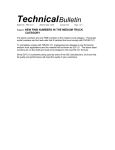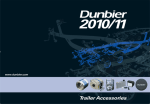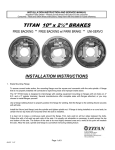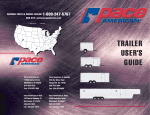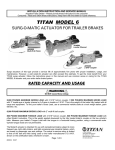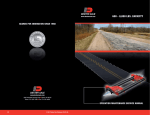Download Trailer Buddy Axle Maintenance
Transcript
Service Information for With patented stainless steel wheel bearing protectors. Spindle Spring Loaded Seal Bearing Cap Hub Patent No. 5,054,859 Check Valve Overflow Cavity Grease Fitting Stainless Steel Bearing Protector Double O-Rings TRAILER BUDDY® AXLE Your trailer is equipped with the Trailer Buddy® Axle. This system has a number of unique features not found on conventional trailer axles. It is the finest quality axle assembly available and is designed for long-term, trouble-free performance. The following information is provided to answer questions you may have regarding maintenance of the product. FULL The hub is full of grease when the blue Autocheck® ring is visible. The cap on the end of the blue ring contains messy grease overflow. GREASE NEEDED CAP 1 Filling the hub with grease is especially easy. Simply remove the cap to reveal the convenient grease fitting. Add grease until the blue Auto Check® ring is visible. 5200# AXLES (6 or 8 lug with old-style protector) Some 5200# axles feature the old-style blue Auto Check visual indicator ring. When the ring is slightly outboard from the steel retaining ring, the hub is properly filled. If the blue ring has receded flush with the steel ring add grease until the blue ring starts to move. It’s that simple! GREASE RELIEVING OUT FRONT OF YOUR 5200# AXLE The protector has a built-in automatic pressure relief feature that prevents overfilling the hub and also prevents rear seal damage. If you try to put too much grease into the hub it will come right back out around the edge of the piston as you trail. No harm will occur; you may get grease on your wheels. If you don’t like grease on your wheels, add a Trailer Buddy bra. WHEN TO CHECK Checking when hubs are warm minimizes overfilling. Checking prior to launching ensures full hubs when the axle is submerged. Adding grease after submersion is too late! RECOMMENDED LUBRICANT You can match the grease already in your hub by using Trailer Buddy Wheel Bearing Grease or use any other good quality, #2 grade multi-purpose grease. Use a water repellent grease if you’d like, but it’s not necessary because water won’t enter a properly filled hub. Grease consists of oil, soap and additives. (The soap in any particular grease has one of several chemical bases [lithium, calcium, etc.]). Oil sometimes separates from the soap and may leak out of the protector or under the rear seal. This is normal and won’t create any problems. BEARING REPACKING There is no need to repack bearings if a good quality lubricant is used and the lubricant level is properly maintained. PRESSURIZED SYSTEM WON’T DAMAGE SEALS The slight (3 psi) pressure your protector maintains inside the hub WILL NOT damage inner seals. Adding grease with a power gun at a service station WILL damage seals! Fill ONLY with a hand gun! 2 TRAILER BUDDY® BRA (for 5200# axles) To keep grease that escapes from the protector off of trailer wheels, you can install the Trailer Buddy® Bra. It fits over the protector and is easily removable for checking the lubricant level. It’s available at your dealer. HOW TO REMOVE A BEARING PROTECTOR The protector is held in the hub by an interference fit. To remove one, lay a block of wood against the side of it and strike the wood with a hammer. Place the wood on the opposite side and hit it again. Continue this procedure until you “walk” the protector out of the hub. Don’t disassemble the protector to attempt to remove it. To install a protector, line it up with the hub, lay a block of wood over the front of the protector and strike the wood with a hammer. The protector is designed to fit tightly into the hub; therefore, it must be carefully aligned with the hub before hammering. BEARING ADJUSTMENT If the bearings need to be adjusted or replaced you must contact UFP first. We will help diagnose the problem and send instructions to assure that the work is done correctly. Failure to contact UFP before the work is begun may void the warranty. Wheel bearings have been precisely torque-set at the factory. To maximize bearing life, we suggest you check bearing adjustment at least once a year by following this procedure. Jack up one side of the trailer. Grip the edge of the tire and see if you can rock or move it. If you can move the outer edge of the wheel more than 1/8” remove the bearing protector, the cotter pin and spindle nut retainer. While rotating hub tighten the spindle nut to 18-20 inch pounds, which is slightly more than “finger tight”. Don’t overtighten. When the nut is positioned properly the wheel should turn easily and there should be no end play (lateral movement) of the hub with respect to the spindle. To replace the nut retainer, find a position where it will fit over the spindle nut so that the cotter pin can be inserted without having to loosen or tighten the nut. Insert a new cotter pin. Recheck end play. Spread the ends of the cotter pin to keep it in place. Replace the protector and add grease as necessary to move the piston outboard about 1/8 inch. 3 BEARINGS Tapered roller bearings, identical to those currently used on many automobiles, are used. Replacements are readily available. Axle Load Capacity 1500#-2500# 2900#-3750# 4200# 5200# (6 Bolt) 2.328” 5200# (6 Bolt) 2.441” 5200# (8 Bolt) Inner Cone Cup L44649 L68149 L68149 25580 25580 25580 L44610 L68110 L68110 25520 25520 25520 Outer Cone Cup L44649 L44949 L68149 LM67048 15123 14125A L44610 L44610 L68110 LM67010 15245 14276 GREASE SEALS Each hub has a rear (inner) seal which keeps grease from leaking out of the back of the hub. The spring-loaded seals used on your axle are the best available for the application. The axle spindles are equipped with permanent, polished stainless steel seal surfaces for the seals to rotate on. By maintaining the grease level, the system continuously lubricates the seal lips. This system should provide up to 100,000 miles of service (many years of use for most trailers) before seals need to be replaced. GREASE LEAKAGE AT REAR SEAL Visually check seals periodically. No rotating seal is perfect. It’s normal to see a film of oil around the seal area. A slight amount of grease leakage won’t hurt anything, but if the leakage becomes excessive it’s time to eliminate the problem. This usually means disassembling the hub and replacing the seal. On axles with drum brakes, you must remove the drum to check the seal condition. If you don’t have to add grease to the brake axle, the seal is working properly. On the other hand, if you find you are constantly adding grease or have to add an excessive amount of grease, the seal is probably leaking or the brake is overheating. You should remove the hub drum and check the brake and seal. Grease leakage can’t be tolerated on axles with brakes because if grease gets on brake linings the brakes won’t help stop the trailer. REPLACING SEALS The hub or hub drum must be removed from the axle and the seal forced out. It is impossible to remove the seal without damaging it. So if you remove it for some reason, plan on replacing it. Because seals are a high quality design not widely available, you will have to obtain a replacement from the dealer, a bearing supply company, the trailer manufacturer or Unique Functional Products. 4 Seals currently in use are: Axle Load Capacity 1500#-2500# 2900#-3750# 5200# (6 Bolt) 5200# (8 Bolt) Seal Outer &Inner Diameter 1.98” x 1.38” 2.33” x 1.68” or 2.56” x 1.68” 3.38” x 2.13” 3.38” x 2.13” Inner Bearing Cone L44649 L68149 L68149 25580 25580 SEAL CONVERSION INFORMATION Seal Description 198-138-SP1-1 233-168-SP2-1 256-168-SP2-1 338-213-SP2-1 SPINDO SEAL Replacement Part Numbers Trailer Buddy NOK CR 07026 AB1990EO 13557 07027 AD2527EO 16657 07028 AD2528EO ––––– 07040 AD8717EO 21352 National 482163N 473317 ––––– ––––– Marine dealers stock Trailer Buddy replacement seal kits, called Spindo® Seal. These are replacement seal systems for use on axle spindles NOT manufactured by us. They aren’t intended for your equipment (which has a superior seal system). WHEEL BOLTS (OR CONE NUTS) If you remove a wheel from a hub it is very important to properly tighten the wheel bolts when you reinstall the wheel. Mount the wheel on the hub and start the wheel bolts into the hub as far as possible by hand. Then, using a proper lug wrench, tighten each wheel bolt moderately tight. Work your way around the wheel, tightening every other bolt until all bolts have been tightened. Then work your way around the wheel again, using the every other bolt sequence, and tighten each bolt to torque recommended by trailer manufacturer. It is important that the wheel be centered on the hub. The wheel may reseat itself slightly during the first miles of travel after installation. After 100-200 miles of travel, check wheel bolt tightness. Check periodically thereafter. DISC BRAKE ADJUSTMENT Not necessary, they are self-adjusting. DRUM BRAKE ADJUSTMENT Drum brakes should be adjusted in the same manner as old-fashioned automobile brakes. Your marine dealer or an automotive service facility can adjust your brakes. Our 10” drum brakes have a capped hole to permit brake lining inspection and access to the brake shoe adjustment star wheel. Remove the trailer wheel to access the inspection hole. 5 Warning: The removal of high spots on brake linings during initial break-in may result in excessive clearance between linings and drum. Therefore, brake shoe adjustment should be checked after the first 300 miles of travel. Thereafter, periodically check brake adjustment depending on service conditions such as miles traveled and downhill braking. Poorly adjusted brakes increase actuator travel and decrease stopping capability. Trailer Buddy self adjusting, ventilated rotor disc brakes are now available on new trailers and as replacements on your existing trailer. Contact your dealer or the trailer manufacturer for details. REPLACEMENT BRAKE PARTS FOR DRUM BRAKES The following information will be helpful if you wish to purchase parts locally. Brake FMSI Hub-Drum Brake Wheel Cylinder Brake Shoe Bolt Pattern Type Diameter (1) Number (2) 5 bolt 10” x 2 1/4” 1 1/8” uniservo 154 6 or 8 bolt 12” x 2” 1 1/8” uniservo 62 (1) (2) Wheel cylinder repair kits are available at most auto parts stores. Take old wheel cylinder parts with you when buying replacement parts. FMSI stands for Friction Materials Standards Institute, an industry group that assigns a standard number to every brake lining manufactured. Stores selling brake shoes should have a catalog to cross reference their products to an FMSI number. BRAKE ACTUATOR Most trailers use a surge type hydraulic actuator to actuate brakes. Make sure it is operating properly and contains sufficient brake fluid. Contact the trailer manufacturer for specific service instructions. BRAKES AREN’T WATERPROOF Unfortunately, the waterproof brake hasn’t been invented yet. Brake manufactures have taken steps to extend the service life of brakes, but eventually water immersion can cause trouble. Salt water is worse than fresh. If the actuating system operates properly, and the brakes are correctly adjusted but won’t work, it’s best to check the brake components. Replace any malfunctioning or badly rusted parts. Disc brakes offer better service life and require less maintenance than drum brakes. REPLACEMENT PARTS If you can’t find replacement parts locally, we’ll be glad to ship them from our factory. We are confident that our products will contribute to your boating pleasure by eliminating worry and trouble with trailer running gear. If we can be of service or answer any questions, please contact us. 6 FIVE YEAR LIMITED WARRANTY Trailer Buddy Axle Systems are guaranteed against bearing failure and against defects in materials or workmanship under normal use and service for a period of five years after the date of trailer purchase by the first owner. Limitations of Coverage This warranty does not cover: Normal wear and tear. Damage resulting from failure to keep bearings lubricated. Damage caused by accidents, road hazards, overload, or modification of products Failure attributable to improper assembly of, or damage to components if hub is removed from axle spindle. Damage caused by use of wheels not supplied by trailer manufacturer. Failure of drum brakes (they are warranted by the brake manufacturer), worn brake linings, or corrosion or damage of brake components caused by moisture or improper adjustment. Disc brakes are warranted for two years against defects in material and workmanship. They are not warranted against damage caused by overload or worn brake pads. This warranty is limited to defective parts replacement only. Charges for installing replacement parts, damage incurred to other equipment as well as incidental or consequential damages connected therewith are excluded. Some states do not allow the exclusion or limitation of incidental or consequential damages, so the above limitations may not apply to you. Repair or Replacement Procedure If a failure or defect occurs during the warranty period, promptly contact warrantor’s (UFP) customer service department. Until such notice is received, UFP will not be responsible for any repair or replacement costs. UFP, at its option, may require return of the axle assembly or the component in question to the factory, transportation charges prepaid. UFP will replace; FREE OF CHARGE, either the entire axle assembly or the part that proves defective, at its option. Any part found not to be defective will be returned freight collect with an explanation. Use of Vehicle Identification Number (VIN) The VIN is a 17-digit number located on the trailer identification label on the left side of the trailer. Be sure to include the VIN number and the date of trailer manufacture in all communications with UFP. Purchaser’s Rights This warranty gives you specific legal rights, and you may also have other rights, which vary, from state to state. Product Improvement UFP has a policy of continuous product improvement. We reserve the right to change or improve the design of our products without assuming any obligation to modify any product previously manufactured. 33598 135 Sunshine Lane • San Marcos, CA 92069 760-744-1610 • Fax 760-744-1616 • www.ufpnet.com











